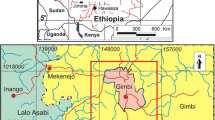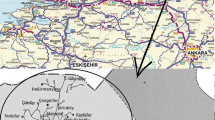Abstract
The present paper deals with landslide hazards in the Ebantu district of the Oromia regional state of western Ethiopia. Ninety-two landslides were recorded during field investigations and Google Earth interpretation. The data sets were prepared as a layer in the spatial GIS database that was later utilized for generating the landslide susceptibility zonation map. Slope, elevation, and distance from drainage were extracted from the digital elevation model, the geology is modified from the geological map of Nekemte, and the land use map was prepared from Landsat +ETM satellite (2015) using digital image processing techniques. The statistical index method was applied to identify landslide hazard areas, and statistical analysis was carried out based on the relationship between past landslides and the causative factors. The causative factor map is further classified into a number of classes based on their relative influence on mass movement and rating values are assigned to each class depending on their influence on slope instability. Based on their assigned weight values, the map overlay process is performed using Arc GIS 10.3, and finally, the landslide hazard map showing various zones is produced by the overlay technique.










Similar content being viewed by others
References
Abay A (2012) Remote sensing and GIS-based mapping on landslide phenomena and landslide susceptibility evaluation of Debresina area (Ethiopia) and Rio sanGirolamo basin (Sardinia). PhD Dissertation, University degliStudi di Cagliari, Italy
Abay A, Barbieri G (2012) Landslide susceptibility and causative factors evaluation of the landslide area of Debresina, in the southwestern Afar escarpment, Ethiopia. J Earth Sci Eng 2:133–144
Aleotti P, Chowdhury R (1999) Landslide hazard assessment: summary review and new perspectives. Bull Eng Geol Environ 58:21–44
Acharya TD, Yang IT, Lee D (2017) GIS-based landslide susceptibility mapping of Bhotang, Nepal using frequency ratio and statistical index methods. J Korean Soc Surv Geodesy Photogrammetry Cartography 35:357–364
Ahmed S (2009) Slope stability analysis using GIS and numerical modeling techniques. Unpublished MSc thesis, VrijeUniversiteit, Brussel
Ahmed B, Rubel YA (2013) Understanding the issues involved in urban landslide vulnerability in Chittagong metropolitan area, Bangladesh. Association of American Geographers (AAG), Washington, DC
Anbalagan R (1992) Landslide hazard evaluation and zonation mapping in mountainous terrain. Eng Geol 32:269–277
Anbazhagan S, Ramesh V (2014) Landslide hazard zonation mapping in Ghat road section of Kolli Hills, India. J Mt Sci 11:1308–1325. https://doi.org/10.1007/s11629-012-2618-9
Ayalew L (1999) The effect of seasonal rainfall on landslides in the highlands of Ethiopia. Bull Eng Geol Environ 58:9–19
Ayenew T, Barbieri G (2005) Inventory of landslides and susceptibility mapping in the Dessie area, northern Ethiopia. Eng Geol 77:1–15
Bai SB, Wang J, Lu GN, Zhou PG, Hou SS, Xu SN (2009) GIS-based and data-driven bivariate landslide-susceptibility mapping in the Three Gorges area, China. Pedosphere 19(1):14–20
Carrara A, Cardinali M, Guzzetti F, Reichenbach P (1995) GIS technology in mapping landslide hazards. In: Carrara A, Guzzetti F (eds) GIS in assessing natural hazards. Kluwer, Dordrecht, pp 135–175
Conoscenti C, Ciaccio M, Caraballo-Arias NA, Gómez-Gutiérrez Á, Rotigliano E, Agnesi V (2015) Assessment of susceptibility to earth-flow landslide using logistic regression and multivariate adaptive regression splines: a case of the Belice River basin (western Sicily, Italy). Geomorphol Elsevier 242:49–64. https://doi.org/10.1016/j.geomorph.2014.09.020
Dai FC, Lee CF, Zhang XH (2001) GIS-based geo-environmental evaluation for urban land-use planning: a case study. Eng Geol 61:257–271
Dai FC, Lee CF, Ngai YY (2002) Landslide risk assessment and management: an overview. Eng Geol 64:65–87
Guzzetti F, Carrara A, Cardinali M, Reichenbach P (1999) Landslide hazard evaluation: an aid to a sustainable development. Geom 31:181–216
Intarawichian N, Dasananda S (2011) Frequency ratio model based landslide susceptibility mapping in lower Mae Chaem watershed, northern Thailand. Environ Earth Sci 64:2271–2285
Krishna CD (2012) Landslide susceptibility mapping using certainty factor, index of entropy and logistic regression models in GIS and their comparison at Mugling–Narayanghat road section in Nepal Himalaya. Nat Hazards 65:135–165
Lee S (2005) Application and cross-validation of spatial logistic multiple regression for landslide susceptibility analysis. Geosci 9(1):63–71
Long NT, De Smedt F (2011) Application of an analytical hierarchical process approach for landslide susceptibility mapping in A Luoi district, Thua Thien Hue Province, Vietnam; Environ Earth Sci 10:011–1397
Meten M, Andary NP, Yatabe R (2015) GIS-based frequency ratio and logistic regression modeling for landslide susceptibility of Debresina in central Ethiopia. J Mt Sci 12(6). https://doi.org/10.1007/s11629-015-3464-3
Narumon I, Songkot D (2010) Analytical hierarchy process for landslide susceptibility mapping in lower Mae chaem watershed, northern Thailand. Suranaree J Sci Technol 17(3):277–292
Neuhäuser B, Damm B, Terhorst B (2011) GIS-based assessment of landslide susceptibility on the base of the weights-of-evidence model. Landslides 9:511–528. https://doi.org/10.1007/s10346-011-0305-5
Peng L, Niu R, Huang B, Wu X, Zhao Y, Ye R (2014) Landslide susceptibility mapping based on rough set theory and support vector machines: a case of the Three Gorges area, China. Geomorphol Elsevier 204:287–301. https://doi.org/10.1016/j.geomorph.2013.08.013
Regmi AD, Yoshida K, Devkota KC, Pradhan B, Pourghasemi HR, Kumamoto T, Akgun A (2013) Application of frequency ratio, statistical index, and weights-of-evidence models and their comparison in landslide susceptibility mapping in Central Nepal Himalaya. Arab J Geosci. https://doi.org/10.1007/s12517-012-0807-z
Rezaei MMH, Khayyam M, Ahmadi M, Farajzadeh M (2007) Mapping susceptibility landslide by using the weight-of-evidence model: a case study in Merek Valley, Iran. J Appl Sci 7(22):3342–3355
Saha AK, Gupta RP, Arora MK (2002) GIS-based landslide hazard zonation in the Bhagirathi (Ganga) valley, Himalayas. Int J Remote Sens 23(2):357–369
Soeters R, van Westen CJ (1996) Slope instability recognition, analysis and zonation. In: Turner AK, Schuster RL (eds.) Landslide investigation and mitigation. National Research Council. Trans Res B 247:129–177
Süzen ML, Doyuran V (2004) Data-driven bivariate landslide susceptibility assessment using geographical information systems: a method and application to Asarsuyu catchment, Turkey. Eng Geol 71:303–321
Temesgen B, Mohammed MU, Korme T (2001) Natural hazard assessment using GIS and remote sensing methods, with particular reference to the landslides in the Wondogenet area, Ethiopia. Phys Chem Earth 26(9):665–675
Thomson S (1971) Analysis of a failed slope. Can Geotech J 8:596–599
Turrini CT, Visintainer P (1998) Proposal of a method to define areas of landslide hazard and application to an area of the Dolomites, Italy. Eng Geol 50:255–265
Vahidnia MH, Alesheikh AA, Alimohammadi A, Hosseinalie F (2009) Landslide Hazard Zonation Using Quantitative Methods in GIS. Intern. Journal of Civil Eng 7(3):176–189
Van Westen C (1997) Statistical landslide hazard analysis. ILWIS 2.1 for windows application guide. ITC, Enschede, pp 73–84
Van Westen CJ, Rengers N, Terlien MTJ, Soeters R (1997) Prediction of the occurrence of slope instability phenomena through GIS based hazard zonation. Geol Rundsch 86(2):404–414
Van Westen CJ, Van Asch TWJ, Soeters R (2006) Landslide hazard and risk zonation - why is it still so difficult?. Bulletin of Eng. Geology and the Envir 65:167–184
Varnes DJ (1984) Landslide hazard zonation: a review of principles and practice. Commission on landslides of the IAEG UNESCO N. Hazards No. 3
Woldearegay K (2005) Rainfall-triggered landslides in the northern highlands of Ethiopia: characterization, GIS-based prediction and mitigation. PhD Thesis. Facul of Civil Eng Graz Univ of Techno
Yalcin A (2007) Environmental impacts of landslides: a case study from East Black Sea region, Turkey. Environ Eng Sci 24(6):821–833
Yalcin A (2008) GIS-based landslide susceptibility mapping using analytical hierarchy process and bivariate statistics in Ardesen (Turkey): comparisons of results and confirmations. Catena 72:1–12
Yalcin A, Reis S, Aydinoglu AC, Yomralioglu T (2011) A GIS-based comparative study of frequency ratio, analytical hierarchy process, bivariate statistics and logistic regression methods for landslide susceptibility mapping in Trabzon, NE Turkey. Catena 85:274–287
Yilmaz C, Topal T, Süzen ML (2011) GIS-based landslide susceptibility mapping using bivariate statistical analysis in Devrek (Zonguldak-Turkey). Environ Earth Sci 65:2161–2178. https://doi.org/10.1007/s12665-011-1196-4
Zhang G, Cai Y, Zheng Z, Zhen J, Liu Y, Huang K (2016) Integration of the statistical index method and the analytic hierarchy process technique for the assessment of landslide susceptibility in Huizhou, China. Catena 142:233–244
Acknowledgements
The authors are grateful to the Ministry of Water Resources of Ethiopia and School of Earth Sciences, Mekelle University for sponsoring the research work as well as different organizations who have helped this study by providing valuable data. These include Ebantu District Administration, Ebantu District Road Authority, Land Administration Office, Nekemte TVET College, Ethiopian Geological Survey and Ethiopian Meteorological Agency. Thanks are also due to Prof. Bheemalingeswara for his comments and help in improving the quality of the paper. Moreover, the authors would like to thank all anonymous reviewers for their valuable comments on the manuscript.
Author information
Authors and Affiliations
Corresponding author
Rights and permissions
About this article
Cite this article
Firomsa, M., Abay, A. Landslide assessment and susceptibility zonation in Ebantu district of Oromia region, western Ethiopia. Bull Eng Geol Environ 78, 4229–4239 (2019). https://doi.org/10.1007/s10064-018-1398-z
Received:
Accepted:
Published:
Issue Date:
DOI: https://doi.org/10.1007/s10064-018-1398-z




